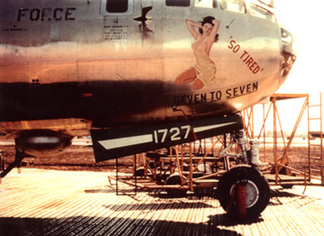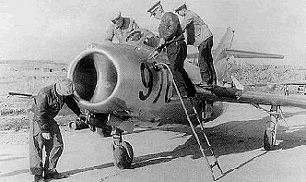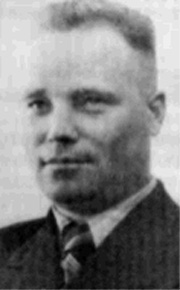|
RB-29 #44-61727 “So Tired” Part 2 Page 1 of 2 Pages Editor: Time marches on and the Korean war moves into the year 1952. RB-29 #1727, in spite of its name “So Tired,” carries valiantly on with evolving changes in both ground and aircrew members. Fate steps in and she and her crew are shot down on a combat mission. Recorded reports as to just what happened have not been available to me until 27 February when a welcome message arrived from TSgt. Kevin O’Neal, stationed at Cannon AFB, Clovis, New Mexico. I will paste in the meat of his message here to put greater form and function to this important story. He writes: “Hello ““In appendix C of The story of The Impact of U.S. Aerial Reconnaissance during the Early Cold War (1947-1962): Service & Sacrifice of the Cold Warriors, It states that a USAF RB-29 was lost on a PHOTINT mission in the Far East Soviet Union over the Sea of Japan on July 4th, 1952. In the footnotes, it states that an unknown number of crewmen were killed or missing. I have found conflicting information in my research and hope this will help correct any errors on both of our parts. |
||||||||
| “I found the following details through my research:
The aircraft, RB-29 (no. 44-61727) departed Yokota Air Base, Japan, at 1858 hours on July 3, 1952 for a night reconnaissance mission. Statements of repatriated crew members reveal that the RB-29 reached the Sinanju area at approximately 2330 hours and encountered sporadic ground fire directed from the bridge complex area. Shortly thereafter it was attacked by MiG-15 aircraft and severely damaged. |
||||||||
 |
||||||||
| At approximately 2343 hours, while at an altitude of 19,000 feet, the crew abandoned the aircraft which crashed some 20 miles southwest of Sinanju.
“The following crew members were onboard: 1Lt. Joseph B. Moreland; 2Lt. Francis A. Strieby; 1Lt. Kenneth S. Brazil; A1C Edwin D. Combs; A1C William B. Koski; SSgt. Charles V. Johansen; A1C Kenneth H. Bass; A2C Donald L. Hand; SSgt. Bernard F. Rivers; A1C Eugene B. Evers; Captain Theodore R. Harris; SSgt. Richard L. Albright; SSgt. Clifford H. Mast. “Further statements from the crew noted that SSgt. Clifford H. Mast was still alive when the last person, 2Lt. Francis A. Strieby, bailed out of the damaged aircraft. Lt. Strieby states that he attempted to push Mast, the nose gunner, out the nose hatch. Mast resisted and took a swing at the copilot who left him standing beside the aircraft commander's seat. The copilot then started across the hatch toward the radio operator's position and encountered fire coming through the forward bulkhead door. This was the last he remembered prior to regaining consciousness in his parachute at an altitude of 1,000 feet. Other reports from repatriated crewmembers state that one crewman had died in the air battle either by ground fire or by the MiG attack. “Soviet transcripts of the events follow:” |
||||||||
 |
||||||||
 |
||||||||
|
Right: The pilot of the picture is Major Anatoly Mikhailovich Karelin, XO of the 351st IAP, the main night fighting unit of the VVS in Korea, who shot down two B-29As of the 28th BS, 19th BW on June 10 1952, while he was flying the MiG-15bis Fagot "325" (the same aircraft used by Col. Pepelyayev during 1951). He also became an Ace, shooting down six B-29s, all of them during night sorties. |
||||||||
|
URL http://dzampini.boom.ru/Korea/MiGsoverKorea.htm Later requests for access to this address received a “not found” indication. We have extracted this Note from that page for your information: “This article mainly contains the Soviet version of the war, combined with Chinese and North Korean data. The American version will be mentioned only when it will be necessary. The intention of this article is to show information from the "other side" of the Korean War, and pay homage to the Soviet, Chinese and North Korean pilots, whose deeds are certainly as remarkable as the ones performed by the American pilots, but also unfairly unknown during a long time. Well, as Venik say, time's up. One more thing: the "Communist" claims in the text do not have the meaning of an actual destruction of an aircraft not confirmed by western sources, but they mean that an attack happens, and during it the pilot considers the enemy plane shot down, opinion what was shared by the pilot's commanders. If there is over-claims in the text, well, remember that also did USAF. This article would be impossible without the help of Venik and the collaboration of my Russian friend Vladislav "PG Monster" Arkhipov.- Diego Zampini.” Editor: We are publishing on these pages some selected illustrations from their web site that will give you a better window of these events from the Communist point of view. End of Page 1 of 2 Pages, Part 2 — Go to Page 2 Cover Page — Editor’s Introduction — Table of Contents
Or You may go to Home - Contact Us - Cold War Hist. - 91st SRS Hist. - Stardust 40 Mission Story |
||||||||